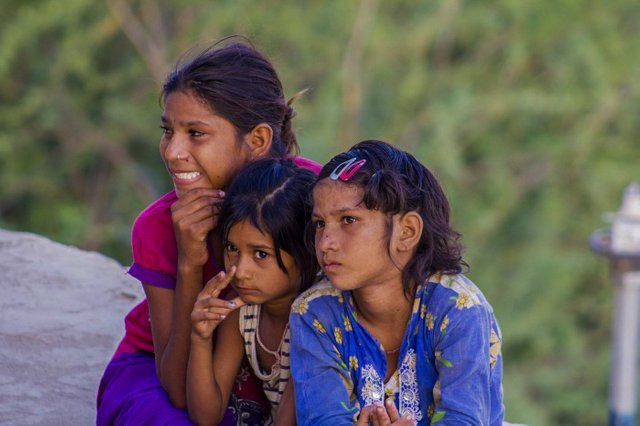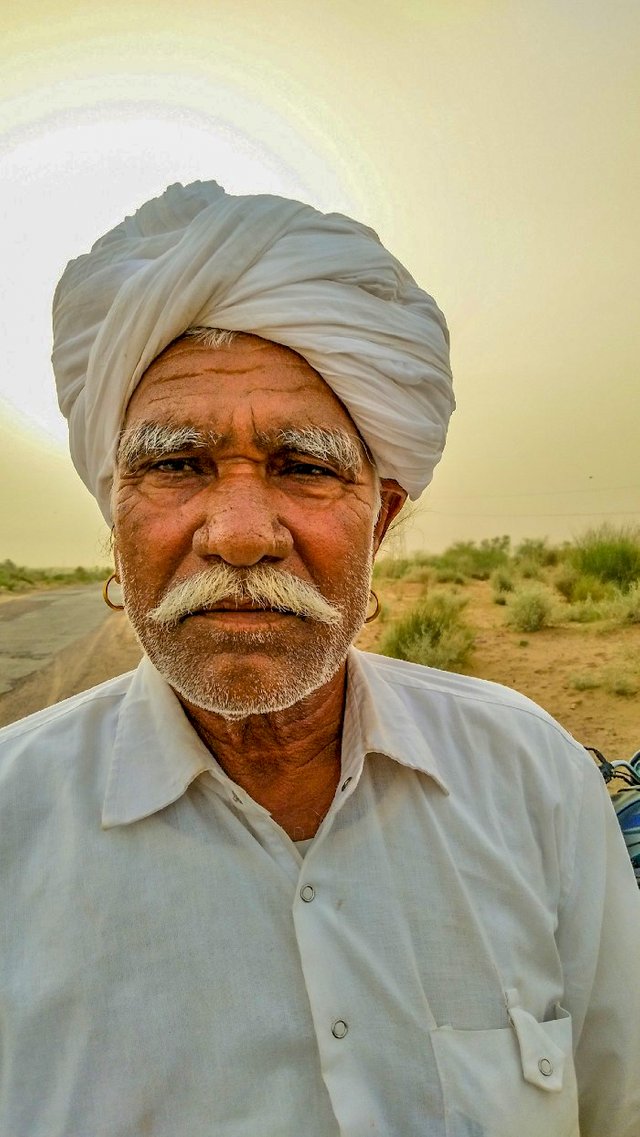
Hello Steemit,
During June 2017 this year, My friend Chirag and I rode through the deserts of western Rajasthan. I am not sure if riding through the desert during the peak of summer was a great idea, but in the hindsight, thanks to the offseason and fewer tourists around, we got to explore and experience the region and the culture in a much more immersive way.
Here is a series of photographs that showcase a sense of the place, the landscape, people, architecture and the culture of the place.

The first thing that we noticed when we crossed over from Gujarat border towards Barmer was the cows. They were big and how. The horns especially were huge. I got caught bang in the middle of this herd trying to get their picture and yes, it wasn’t easy being in the middle of these bovine giants.

The desert roads. This was enroute Barmer from Sanjore.

Soon the sheep followed. Since most of the area around is desert and barren, agriculture is not really practised much. So animal husbandry is most preferred and it is very common to see people with large herds of cows and sheep on the roads.

Local boys pose with the bike. People travelling on bike and that too such long distances is something that is out of the ordinary for them. While the elders were keen to know our stories and reasons to travel, the boys were just interested in knowing about the bike. Their favourite question — ‘How fast can it go?’

From Barmer, instead of taking the main highway towards Jaisalmer, we lost our way and we're heading towards Munabao, a small hamlet located on the border of India-Pakistan. However, we soon realised and took an alternative road to Jaisalmer.
Stopped for breakfast at a small hotel. The people of these villages were quite surprised to see us on the bike as other than locals and army, not many tourists ply on these roads.

The interior roads in the deserts of Rajasthan. After losing our way, we ended up taking an alternative and closer route to Jaisalmer. It took us right through the heart of the desert and through some really interior villages. While there was a road shown on Google maps, this is how it looked in reality.

The Jaisalmer fort during night. Much of Jaisalmer fort is centred around the beautiful golden coloured fort. It is also the oldest fort which is still inhabited by people. There is a thriving community that has been staying in the fort for generations together and now run various business that caters to tourists such as hotels, guest houses & cafes.

A lowered bed used by the royals at Jaisalmer. It was believed that the royals would sleep on this bed with both their feet placed dangling off the bed. This was practised to ensure that they are combat-ready just in case someone attacked during the night.

A view of the Jaisalmer city from the fort. Most of the buildings in Jaisalmer still follow the traditional style of architecture and ensure that the outside of the structure is made from the blocks that are locally available.

Another view of the Fort and the city outside. The roads inside the fort are mostly cobbled and narrow.

The narrow inside lanes of the Jaisalmer fort.

Shops located inside the fort. They mainly cater to the interest of the hordes of tourists who visit the fort.

A typical household inside the Jaisalmer fort.

An old man stands near the entrance of his house inside the fort. Most of the houses have families staying in the same house for generations together, from the times of kings and kingdom existed.

A Manganiyar singer singing for the tourists who have come to see the sunset at Sooli Dungar at Jaisalmer. Manganiyars are Rajput Muslims who sing for a living. They were known to sing for the kings, royalty and the aristocratic class back during when the kingdoms existed. Most of their musical knowledge is passed down through generations and they are known for their earthy and traditional style of singing.

The local children gather to hear the music at the sunset point. I am not sure if they were more intrigued by the music or the foreign tourists who had come to see the sunset.

Gadsisar Lake is a beautiful lake built by the first ruler of Jaisalmer and later rebuilt and revamped by Maharaja Garisisar Singh. The lake served as the main water source for the city.
The catchment area is adorned by artistically carved Chattris, Temples, Shrines, and Ghats on its sides.

Patwon ki Haveli in Jaisalmer. Patwas were considered to be the richest family in Jaisalmer. They were traders who had trading links with far west Asia, Africa and a host of other countries. During difficult times, they have been known to have given loans to even the kings of Jaisalmer.
This beautiful and tastefully built haveli (home) is a testament of the grand times they lived in.

A local musician plays for the tourists opposite the Patwon ki Haveli, a local tourist attraction. Music is very integral to Rajasthani culture and is representative of the earthiness and rootedness of the culture here.

Rajasthan is known for its spicy and colourful food. Rich in taste and appearance, most of the delicacies are made using local ingredients and some unique local preparation methods. In this picture is ‘Laal Maas’, a very popular mutton dish in Rajasthan.

An old man waits for his daily bus in Ghantiyali village near Indo-Pak border, very close to Tanot. This desert village has some 20 homes. Living conditions are difficult given the harshness of the desert.

A camel takes a break under the tree to escape the scorching midday heat. During summers, the temperature can go up to 50-degree Celsius and the hot winds that blow make the place unbearable.

A local woman carries water back home in a clay pot. Water is a scarce resource and womenfolk have to walk quite a few kilometres to fetch even something as basic as drinking water.

A local village panchayat head. Many of the villages located in the desert are very small with hardly a few huts. Most of them are not even on the map. Such remoteness has not deterred the people of these villages from keeping up with times. While a lot desires to be improved, local governance bodies are working to ensure better living for the people here.

The purdah system is a popular and controversial tradition in Rajasthan. As per this, most women are expected to wear a purdah (veil) to cover their faces in front of all men and when in public places.
While I saw a considerable number of women following the tradition, I must admit that I saw an equal number of women, both in the cities and in hinterlands who did not cover their faces.

Camels, Peacocks roam freely on both the highways and villages in western Rajasthan. While I was surprised to see peacocks and camels in the middle of the villages during broad daylight, I realised from the reactions of villagers that this was a daily occurrence and nothing out of the ordinary.

The Junagarh fort at Bikaner. This fort was continuously built over 7 generations of royalty.

The grand interiors at Junagarh fort in Bikaner. The fort is influenced by the Rajput and the Mughal style of architecture.
— — — — — — — — — — — — — — — — — — — — — — — — — — — — — -
Our ride through western Rajasthan was eventful and memorable. Even the peak summer heat could not bring our spirits down. Set against the monotonous background of the desert, the colourful culture, dressing, food and people of the region really stood out and formed a lasting impression.
From here we rode ahead, exploring the border areas of India-Pak in Punjab, and then eventually heading over to the mountains in Himachal. More about that in another post.
If you liked this post, do resteem it and don't forget to upvote it. if you like to read more travel stories from India on a motorbike, do follow my profile.